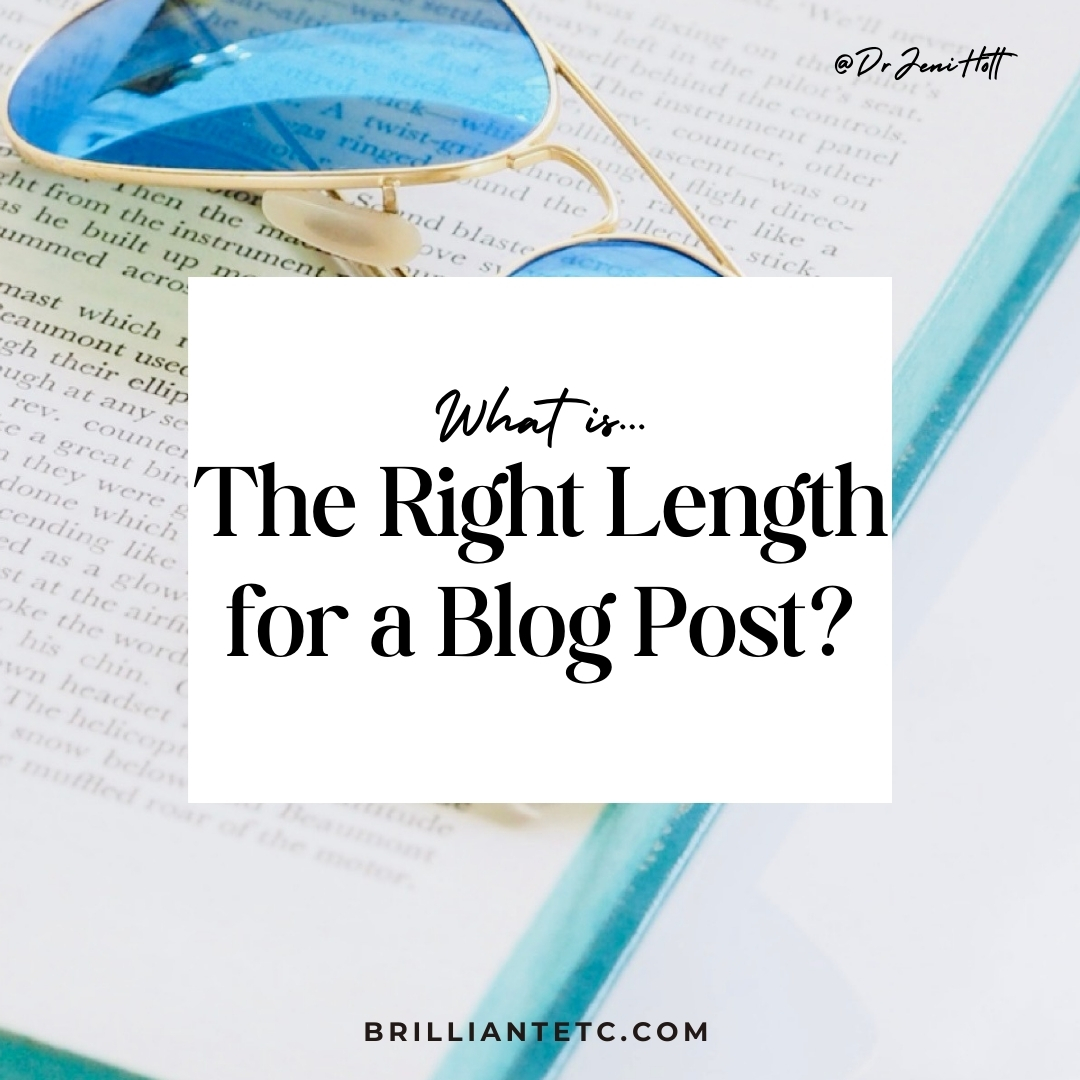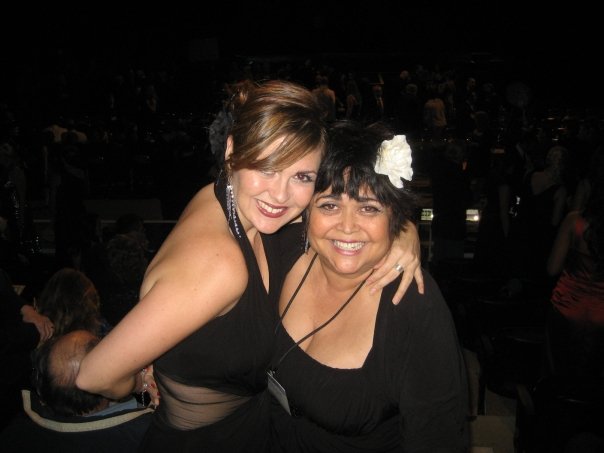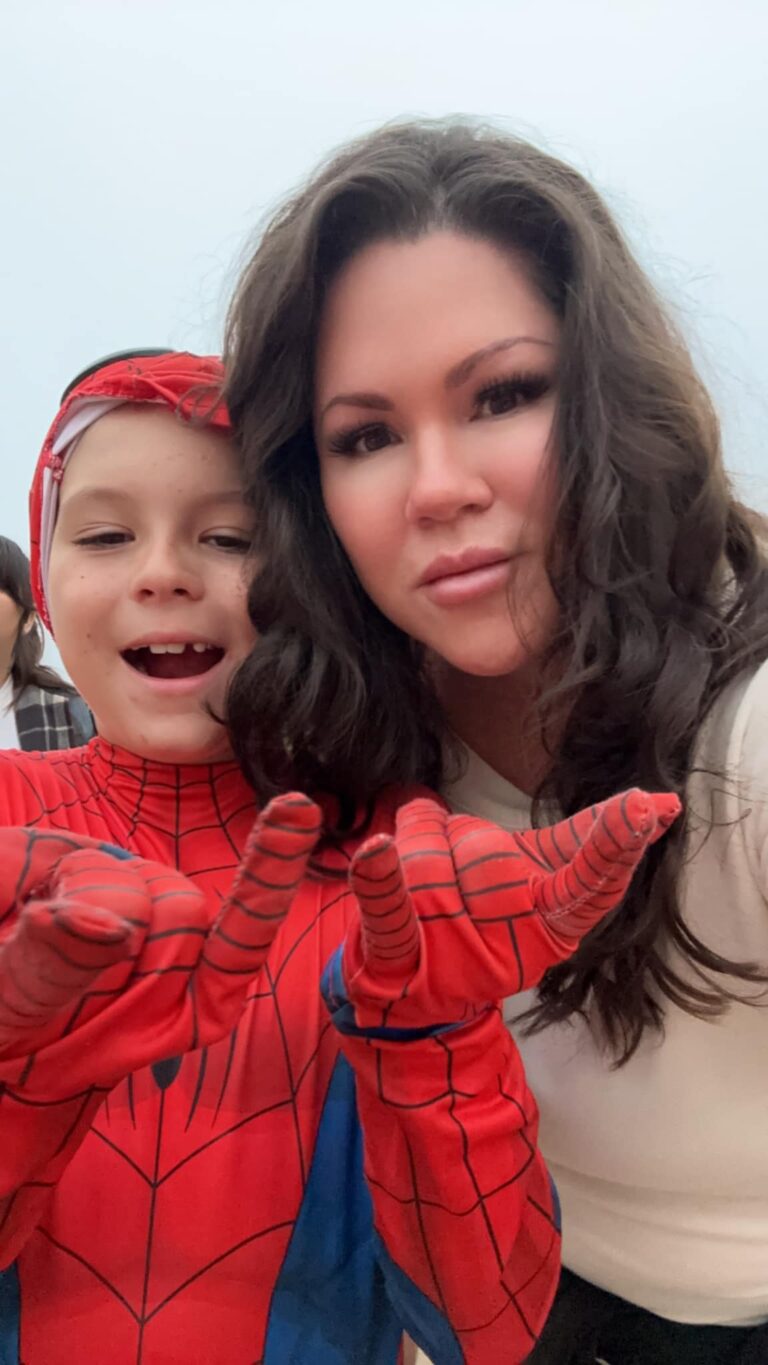What is the Best Blog Post Length in 2025? [Complete Guide from a 20 year+ Blogger]
Yes, there absolutely is a best blog post “sweet spot” length and I’m going to map it out for you.
I’ve been blogging for over two decades— long before “content marketing” was even a buzzword.
In that time, I’ve seen every possible content-length hack and trend come and go:
- The 300–500 word quick posts that ranked effortlessly in the early 2000s
- The “write 1,000 words for SEO” advice of the 2010s
- The skyscraper post craze where 4,000+ words became the default recommendation (ugh)
- And now, in 2025, a new reality: quality and relevance beat raw word count every. single. time.
Here’s it is in a nutshell:
For most blog posts in 2025, the sweet spot is 1,800–2,400 words.
But word count alone won’t get you to page one anymore.
The real winners are the posts that (now pay attention to this part if you want to outrank the big boys):
- Match search intent perfectly
- Answer follow-up questions before the reader asks them
- Keep people engaged until the end (Seriously- this is important)
So forget the trends or the ‘advice-of-the-day’ that you see on Instagram. This is what really matters. And while it’s always mattered in some sense- now it’s crucial if you want to rank.
This guide breaks down not just the numbers — but the why, the how, and the real-world examples that prove what works now.
Why Word Count Still Matters (But Isn’t Everything)
A 2024 Semrush analysis found that blog posts between 1,800–2,400 words averaged 15–20% more organic traffic than both shorter and longer posts. Not because of the number alone — but because those posts were the most likely to match search intent in full.
Yes, word count still influences rankings — but Google’s algorithm has matured.
It’s no longer enough to just write long content. Today, Google prioritizes:
- Helpfulness over padding
- Depth over length
- Reader satisfaction signals like time-on-page, scroll depth, and bounce rate
Think of it this way:
A 2,200-word post that’s tight, clear, and satisfying will still outrank a 1,000-word post — but only if it fully answers the query.
On the flip side, a bloated 3,000-word article that meanders will get beaten by a focused, 1,200-word post that nails it and leaves the reader feeling done.
In all honesty? These are the days I was praying for back when content fluff and keyword stuffing reigned supreme and exactly why I refused to cave and ALWAYS focused on my audience.
There were times when the algorithms did not favor me because of this, but… I managed a workaround by turning my audience into loyal fans and then adoring love slaves…. to the tune of millions of readers a month.
So the lesson in this part? Focus on your audience FIRST, and word count second… and ask yourself this- what is it about these new metrics that is making people soooo happy that the algorythm is now prioritizing them?
Now that said… let’s get into specific numbers because, as I mentioned above- it’s all about what the reader wants 🙂
Best Blog Post Lengths by Content Type (2025)
Different types of content have different reader expectations — and different optimal lengths.
Here’s a quick reference chart you can use when planning your next post:
| Content Type | Ideal Word Count |
|---|---|
| Listicles / Roundups | 1,800–2,200 words |
| How-To Guides | 2,000–2,400 words |
| Product Comparisons | 1,500–2,000 words |
| Case Studies | 1,200–1,800 words |
| Thought Leadership Posts | 1,000–1,400 words |
| Landing Pages / SEO Pages | 800–1,200 words |
| News / Announcements | 500–800 words |
🧠 SEO Tip: Naturally include variations like:
- best blog post length 2025
- ideal word count for blog post
- SEO blog post length
- perfect blog length for Google
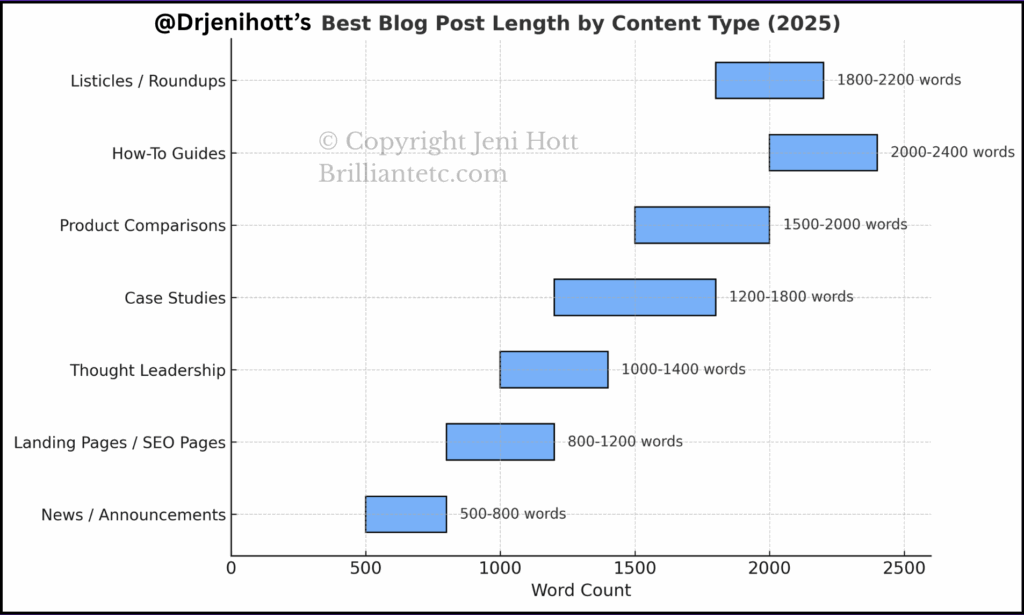
How Google Decides Who Wins Now
In 2025, Google uses far more behavior-based signals than it did five years ago. That means your post needs to win on:
- Topical Coverage – Fully answer the main query and related sub-questions.
- Time-on-Page – Keep readers scrolling with strong formatting and visuals.
- Dwell Time & Bounce Rate – If people leave quickly, you’ll sink. If they’re bouncing.. they didn’t find what they wanted- wether because the content lacked or the site glitched etc.
- Internal Linking – Show topical authority by linking to your related posts, like:
- [How to Plan Evergreen Content That Stays Relevant]
- [SEO Copywriting for Beginners: A Psychology-Backed Guide]
- [Blog Monetization in 2025: 7 Low-Effort Income Streams]
The Skimmability Factor (and Why Your Brain Loves It)
Reader attention is short. Like, really short.
And here’s the thing — it’s not because people are lazy. It’s because your brain is a master at conserving energy. In neuroscience, this is called cognitive efficiency. Your brain will always choose the path of least resistance to get the reward it wants — in this case, information.
In 2025, that brain is flooded with a constant stream of notifications, feeds, and digital noise. When it lands on a blog post, it’s already in triage mode:
“Does this look like work… or does this look like something I can absorb fast?”
If the brain subconsciously tags your post as “work” — it’s over. The tab closes, your bounce rate spikes, and Google takes note.
Why Skimmability Works So Well
When a post is visually inviting, the brain gets a hit of dopamine before it’s even read a word. It feels a sense of “I can do this,” which keeps the reader scrolling. This isn’t just a design choice — it’s a retention strategy.
Before & After: Skimmability in Action
Before:
“In order to determine the best blog length for your niche, you first have to analyze your audience and understand the kind of questions they’re asking. Once you have a clear picture of their needs, you can assess the competitive landscape, identify ranking opportunities, and match your word count to what the top-performing content is doing, while also ensuring that your post goes deeper or offers something unique.”
After:
Step 1: Know what your audience is asking
Step 2: Check what’s already ranking
Step 3: Go deeper or offer something different
Same advice. Half the words. Twice the impact.
Reader-Friendly Design Tricks
Beyond headings and bullets, here’s how to make your post instantly more inviting:
- Keep paragraphs to 2–4 sentences — anything longer looks like homework.
- Use “soft visuals” like screenshots, charts, and icons to break up text.
- Pull out key phrases in bold so scanners catch the main ideas.
- Add subheader rhythm — a subheader every 200–300 words to reset the reader’s attention.
- Insert quick summaries at the end of major sections so skimmers still get value.
Bottom Line on Skimmability
Formatting isn’t just aesthetics — it’s neuroscience-backed engagement insurance. The easier you make it for the brain to win, the longer the reader will stay… and the better your post will rank.
Case Study: When Shorter Wins
One of my Time Rich Business™ students came to me frustrated. She had poured her heart into a 3,000-word how-to guide for beginner wedding photographers.
It was beautifully written, full of tips, and honestly… a labor of love.
But after 3 months?
- Page 5 on Google (if you were patient enough to click that far)
- Bounce rate over 80%
- Average time on page: just 40 seconds
The problem?
She had fallen into the “more is more” trap — stuffing every possible angle into one post without thinking about how a beginner would actually consume it.
The Fix
Here’s what we did:
- Trimmed it from 3,000 words to 2,050 — every sentence had to earn its place.
- Grouped tips into 7 core sections instead of 19 scattered subpoints.
- Added subheadings every 200–300 words so readers never felt lost.
- Turned three long paragraphs into step-by-step numbered lists.
- Dropped in before/after photo examples so her audience could “see” the advice.
- Added internal links to spin-off posts for deep dives instead of overloading one article.
The Results
Within three weeks:
- Jumped from page 5 to position #3 on Google for her main keyword.
- Bounce rate dropped from 80% to 52%.
- Average time on page doubled to 1 minute 25 seconds.
- She even got two inquiries for paid photography lessons directly from that blog post.
The Takeaway
Longer isn’t always better.
A post that’s 1,900–2,200 words but laser-focused and easy to navigate will beat a bloated 3,000+ word piece almost every time.
The secret is to make the reader feel like:
“This is exactly what I needed, nothing more, nothing less.”
That’s the sweet spot where rankings, retention, and conversions all meet.
How to Decide Your Ideal Blog Post Length
There’s no magic number — but there is a decision process.
There’s no magic number that works for every post — but there is a repeatable process for figuring it out before you even start writing.
Think of it like packing for a trip:
- The length of your “packing list” depends on where you’re going, what you’ll be doing, and how prepared you want to be.
- Overpack, and you’ll drag around a heavy suitcase nobody wants to carry.
- Underpack, and you’ll be running to the store on day one.
Your blog content is the same way — the goal is enough to deliver exactly what the reader came for, without making them work for it.
Step 1: Identify the Search Intent
Ask yourself:
- Informational: Are readers here to learn how to do something?
- Transactional: Are they deciding what to buy?
- Navigational: Are they looking for a specific brand, site, or product?
Rule of thumb:
- Informational → usually longer (2,000–2,400 words)
- Transactional → medium length (1,500–2,000 words)
- Navigational → shorter, direct (800–1,200 words)
Step 2: Audit the Competition
Search your target keyword and check the top 3–5 results.
- How long are they?
- Are they well-structured or bloated?
- Do they really answer the question, or can you see gaps?
Pro tip: Don’t just match their word count — match or exceed their helpfulness.
Step 3: Decide How Deep You’ll Go
Ask:
- Will I include examples, stats, or expert quotes?
- Will I break the topic into multiple posts or cover everything here?
- Are there subtopics my audience will expect in the same post?
The deeper you go, the more words you’ll naturally need — but depth should come from adding value, not adding filler.
Step 4: Match to Content Type
Use the Best Blog Post Lengths by Content Type chart in this guide as your baseline.
- Writing a how-to? You’ll likely land in the 2,000+ range.
- Writing a quick news update? You can be done in 500–800 words.
Step 5: Build for Engagement, Not Just Length
No matter the word count, you need to keep people scrolling.
- Break the post into logical, titled sections.
- Use bullets, numbered steps, and images.
- End each section with a line that naturally leads into the next.
The Flowchart Shortcut
If you want the quick, visual way to do this, use my Blog Post Length Flowchart:
Bottom Line
The right blog post length isn’t about hitting a magic number — it’s about hitting the sweet spot where reader satisfaction and search visibility overlap.
When you plan length with intent, you’re no longer just “writing content” — you’re engineering a piece of content designed to rank, retain, and convert.
Here’s the quick flowchart I use with students:
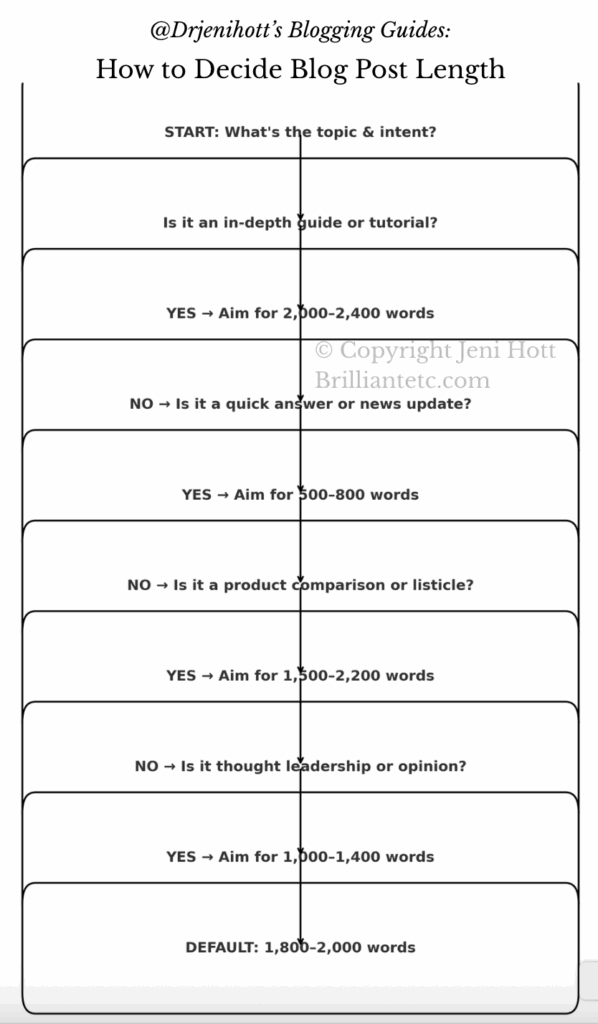
Examples of Top-Ranking Blog Posts in 2025
1. Ahrefs – SEO Copywriting Guide (~2,248 words)
- Hits every keyword variation naturally
- Includes examples, answer boxes, and visuals
2. Wix – Blog Length Post (~2,200 words)
- Clear structure with lists & summaries
- Strong internal links to tools and related guides
3. Neil Patel – Content Length Post (~1,900 words)
- Jargon-free language
- Smart use of related queries and examples
The Trend Truth From a 20+ Year Blogger
Trends always change.
In my 20+ years of blogging, I’ve seen this in every niche:
- Fashion: hemline trends flip every decade
- Fitness: workout fads rise and fall
- Business: marketing channels go from hot to cold in months
Content is no different.
In some niches, 3,000+ word deep dives win.
In others, 700–900 words is gold because the audience wants speed.
The secret?
Know your audience and your competitive landscape right now — not last year.
Final Takeaway
Google rewards what your readers want and stick around for: intent-driven, skimmable, linkable content.
That means:
✅ Match searcher questions exactly
✅ Use subheaders for structure
✅ Add visuals and internal links
✅ Aim for 1,800–2,400 words when it adds value
✅ Sprinkle in semantic variations naturally
The best blog post length in 2025?
The one that answers your reader’s question so completely… they stop searching.
FAQs
FAQs — Expanded for 2025
Jeni, how do you decide how long your post should be?
I don’t worry about it. I write with a focus on, what do they want to know… and what do they need to know- then I think, how can I make this easily consumable… and maybe a little fun 😉
How long should a blog post be for SEO in 2025?
Aim for 1,800–2,400 words depending on topic depth and search intent. This range gives you enough space to satisfy Google’s quality signals without padding.
Can short blog posts still rank?
Absolutely — if they fulfill intent better than longer ones. A 700-word post can beat a 2,000-word post if it’s cleaner, faster to read, and answers everything.
Does Google have a minimum word count?
No. But thin content under 300 words rarely ranks unless it’s hyper-specific and answers the query perfectly.
How do I know if my blog post is too long?
If you find yourself repeating points, drifting off-topic, or losing reader engagement halfway, it’s too long. Use analytics to see where readers drop off.
Does updating old posts help with rankings?
Yes — updating with fresher data, better formatting, and more complete answers can quickly revive rankings, sometimes faster than writing new content.

